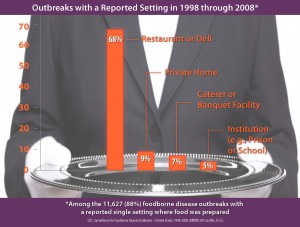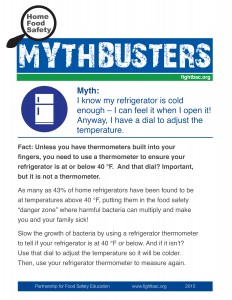
While it’s always good to be wary of public education campaigns driven by commercial interests, a new effort by the food industry to communicate about preventing food borne illness by improving home food safety has a few worthy elements. The new “Mythbusters” campaign aims to increase safe food handling in homes, which are the source for about 9% of food-related sickness in the United States each year. Commercial or restaurant kitchens are the source for most food borne disease, accounting for about seven times more cases than private kitchens.
The skeptic in me questions why backers like Foster Farms, Cargill, and the trade associations representing manufacturers of most of the food items that wind up in grocery stores and commercial kitchens, want to shine the light on home kitchens more than safety improvements in industrial food processing. To be fair, the large companies do pay attention to food safety, and I am unlikely to ever be completely comfortable eating factory-farmed, processed products. If they are doing their part, then asking consumers to be careful with home food safety, too, probably makes sense.

Food safety is serious business. According to the Centers for Disease Control and Prevention, 3,000 people die every year from consuming contaminated food or beverages, many thousands more are sickened.
Food prepared in home kitchens accounts for a lot of illness, but it’s a minor factor compared to restaurants or delis where many people can be exposed to contamination. Based on 10 years of data, the CDC estimates that nearly 7 out of every 10 cases of food borne illness are traced to restaurants, 1 out of every 10 to foods prepared in a private home, and the rest are attributed to caterers or institutional kitchens.
The project’s website has fact sheets, videos, and other resources to help families keep their home kitchens and the foods they eat safer. For example, a safe school lunch flyer reminds people to use separate cutting boards for meats and vegetables and use insulated bags, freezer gel packs or a frozen juice box to help keep lunches safe after they go out the door.

